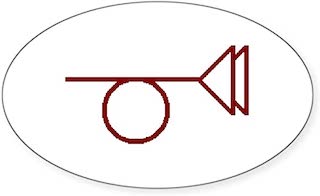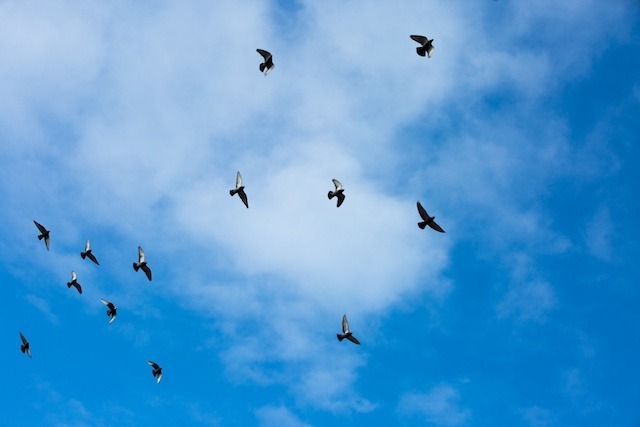
Birds flying: ‘What is at stake is only everything we have.’ –Yolanda Kondonassis (Photo: George Hodan, CCO Public Domain)
By David McGee
FIVE MINUTES FOR EARTH
Yolanda Kondonassis
Azica Records
THE LOST BIRDS: An Extinction Elegy
Christopher Tin
Royal Philharmonic Orchestra with VOCES8
Decca Classics
AVIARY
Gary Wood & Philip Swanson
MRS Classics (May 2020)
Some would argue for the signs of civilization’s imminent demise being evident all around us. The artists/composers represented in the albums featured here are focused singularly—and profoundly–on environmental apocalypse, the shadows of manifold dangers that, should they remain unaltered, doom our planet.
Two years ago composer Philip Swanson and vocalist Gary Wood sounded a gentle alarm in the form of Aviary (subtitled Birds in Poetry and Song), a song cycle celebrating our fine feathered friends, featuring a 13-part musical adaptation of Wallace Steven’s 1954 poem, “Thirteen Ways of Looking at a Blackbird,” along with Swanson’s newly composed pieces supplemented by standards from the Great American Songbook, jazz sources and poetry reimagined in musical terms. Whereas Aviary is inspired by birds as things of beauty, mystery and inspiration, Grammy winning composer Christopher Tin (who has the distinction of being the only composer ever to win a Grammy for a song written for a video game) is more alarmist in his concerns on the latest powerful entry in his recent works devoted to underscoring the gravity of diminishing natural resources; this one, The Lost Birds: An Extinction Elegy, offers his orchestrations, sensitively (and often majestically) performed by the Royal Philharmonic Orchestra, of 10 poems by female poets of the 19th century who were even then suggesting the magnitude of humanity’s loss should birds vanish from the skies, with the poets’ words given enhanced gravitas by the haunting choral performances of VOCES8. Earlie this year, classical harpist Yolanda Kondonassis delivered Five Minutes For Earth, an ambitious—and brilliant–project that, as she writes, “both celebrates our planet and illuminates our challenge to preserve it.” The concept: Ms. Kondonassis invited 15 composers to contribute new original works for solo harp of no more than five minutes in length expressing their own feelings about the issues facing our planet. This multi-generational grouping, comprised of rising young composers; experienced, lauded veterans; two Grammy winners; and a Pulitzer Prize winner (plus one artist who is both a Pulitzer and Grammy winner), responded with heart and soul, and Ms. Kondonassis took all their contributions to the next level with her interpretive harp performances employing manifold techniques and sonorities to achieve the composers’ intended moods and perspectives in a way that underscores her debt to the classical harp’s two towering innovators/theorists/composers/teachers: Carlos Salzedo (1885-1961), who forever transformed the classical harp from a supportive element lending romantic atmospherics in orchestral settings to a versatile, even daring, expressive lead instrument capable of manifold tonal and textural possibilities; and Marcel Grandjany (1891-1975), who shared Salzedo’s revolutionary bent while stressing in his works the importance of always being a musician first, a technician secondarily. (Both artists also taught at the Juilliard School, Salzedo in 1937, Grandjany following him a year later and being named the first Head of the school’s Harp department.) In each case here, the titular artists offered valuable insight into their projects in their own liner booklets, excerpts of which will prove valuable to understanding the animating conceptual spark coming to fruition on each disc.
FIVE MINUTES FOR EARTH
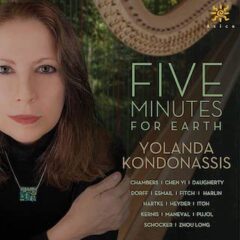 Yolanda Kondonassis writes: “Five Minutes for Earth is a project that both celebrates our planet and illuminates our challenge to preserve it. In 2020, I asked each of the composers featured in this collection if they would consider contributing a work for solo harp of approximately five minutes in length that expresses a powerful experience inspired by Earth in one of its many conditions or atmospheres. I was overwhelmed by the generosity of immediate responses and set about assembling this labor-of-love project. The endeavor quickly expanded to include a live, multi-media concert, fifteen unique videos for each track, a separate published collection of Earth-inspired solos for younger harpists, and most importantly, the opportunity for harpists all over the world to perform these innovative, Earth-inspired works for solo harp by some of today’s most lauded composers; in doing so, every verified performance of any of the works from the Five Minutes for Earth collection, anywhere in the world, will result in a monetary contribution to a recognized earth conservation organization, sponsored by my non-profit organization, Earth at Heart. Five Minutes for Earth is also a metaphor for the urgent and compressed timeframe that remains for our global community to embrace and implement solutions to our fast-growing environmental crisis. What is at stake is only everything we have.”
Yolanda Kondonassis writes: “Five Minutes for Earth is a project that both celebrates our planet and illuminates our challenge to preserve it. In 2020, I asked each of the composers featured in this collection if they would consider contributing a work for solo harp of approximately five minutes in length that expresses a powerful experience inspired by Earth in one of its many conditions or atmospheres. I was overwhelmed by the generosity of immediate responses and set about assembling this labor-of-love project. The endeavor quickly expanded to include a live, multi-media concert, fifteen unique videos for each track, a separate published collection of Earth-inspired solos for younger harpists, and most importantly, the opportunity for harpists all over the world to perform these innovative, Earth-inspired works for solo harp by some of today’s most lauded composers; in doing so, every verified performance of any of the works from the Five Minutes for Earth collection, anywhere in the world, will result in a monetary contribution to a recognized earth conservation organization, sponsored by my non-profit organization, Earth at Heart. Five Minutes for Earth is also a metaphor for the urgent and compressed timeframe that remains for our global community to embrace and implement solutions to our fast-growing environmental crisis. What is at stake is only everything we have.”

‘Inconvenient Wounds,’ composed by Reena Esmail for Yolanda Kondonassis’s Five Minutes for Earth project. Yolanda Kondonassis on harp.
The pedal harp hardly being the most ubiquitous (or popular) instrument for solo work in any genre, listeners may be pleasantly surprised by the variety of sounds and effects a virtuoso can draw from its 47 strings. Five Minutes for Earth is not about Ms. Kondonassis’s virtuosity, however. Yes, she bends strings, she hammers on notes, she conjures a sound like thunder with a percussive effect, she employs scordatura tuning, but her program here is largely in the meditative and reflective realms. Reena Esmail’s “Inconvenient Wounds,” one of the more volatile pieces, evokes a world in tumult, with gentle, plucked passages alternating with cascading glissandos and thunderous hammering, in a near-seven-minute composition that is equal parts peace and soothing silence, and violent outbursts—a world being formed. Ms. Esmail, one of the younger contributors to this effort, is described in her liner profile as working “between the worlds of Indian and Western classical music, bringing communities together through the creation of equitable musical spaces.” (She is Co-Chair of the Board of New Music USA and co-founder/artistic director of Shastra, a non-profit organization that promotes cross-cultural music traditions of India and the West.) “On Hearing Nightbirds at Dusk,” one of the album’s gentlest moments, is as soft and delicate as the scene its title describes, quite Impressionistic in effect, coming from Pulitzer, Grammy and Grawemyer Award winning composer Aaron Jay Kernis. In the sequence here, it serves as a thoughtful interlude before the eruption that is Chen Yi’s “Dark Mountain,” another tumultuous piece with contrasting textures evoking a hard land. Ms. Yi, a Distinguished Endowed Professor at the University of Missouri-Kansas City Conservatory, is described as “a composer who blends East and West traditions, transcending cultural and musical boundaries.” There is another harpist in the Five Minutes fold in veteran composer Gary Schocker (also a pianist and solo flutist with what the liners say is “several hundred” compositions for the flute to his credit), who finds an empathetic interpreter in Ms. Kondonassis’s deeply introspective exploration of tone and texture on Mr. Shocker’s lovely “Memory of Trees.” Patrick Harlin, another young contributor (currently Composer in Residence with the Lansing Symphony Orchestra), “takes musical inspiration from classical, jazz and electronic music traditions, all underpinned with a love and respect for the great outdoors,” offers “Time Lapse,” a work true to its title in sounding and feeling, in its ever unfolding structure, like a musical interpretation of something—a flower, perhaps–slowly blooming, new life, sweet and beautiful in effect. Nine of the 15 compositions actually exceed the five-minute mark (with Pulitzer Prize winning opera composer Zhou Long’s somber, minimalist gem, “Green,” clocking in at eight minutes-plus), but what’s a few minutes’ overtime for a good cause?

‘Kohola Sings,’ composed by Takuma Itoh, for Yolanda Kondonassis’s Five Minutes for Earth. Yolanda Kondonassis on harp.

‘Milonga para mi Tierra,’ composed by Maximo Diego Pujol for Yolanda Kondonassis’s Five Minutes for Earth project. Yolanda Kondonassis on harp.
That Five Minutes for Earth has a purpose beyond its own existence, with Ms. Kondonassis’s non-profit organization contributing to earth conservation organizations with every verified performance of the works herein, is another reason it ranks with this year’s most important recordings. Given the artist’s stated goal to make it “a musical ode to our Earth in all its glory, beauty and pain—past, present and future,” its aim is true.
THE LOST BIRDS
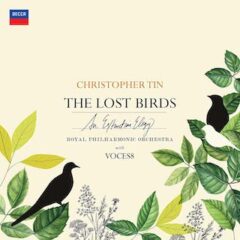 Christopher Tin writes: “The sky was once full of birds. Magnificent flocks so enormous that they would darken the skies for days as they flew overhead. The most awe-inspiring of these flocks belonged to a bird called the passenger pigeon. At their height, they were the most numerous bird species in North America with a population estimated at 5 billion. But over the course of a few decades, we eradicated them for food, using nothing but the crudest 19th century hunting technology. With callous indifference, we simply shot them out of the sky, one by one, until their songs were never heard again.
Christopher Tin writes: “The sky was once full of birds. Magnificent flocks so enormous that they would darken the skies for days as they flew overhead. The most awe-inspiring of these flocks belonged to a bird called the passenger pigeon. At their height, they were the most numerous bird species in North America with a population estimated at 5 billion. But over the course of a few decades, we eradicated them for food, using nothing but the crudest 19th century hunting technology. With callous indifference, we simply shot them out of the sky, one by one, until their songs were never heard again.
“The Lost Birds is a memorial for their loss, and the loss of other species due to human activity. It’s a celebration of their beauty—as symbols of hope, peace and renewal. But also mourns their absence—through the lonely branches of a tree, or the fading echoes of distant bird cries. And like the metaphor of the canary in the coal mine, it’s also a warning: That unless we reverse our course the fate the befell those once soaring flocks will be a foreshadowing of our own extinction. …
“We are now in the 21st century, and our tools for affecting the world around us—emissions, pesticides, deforestation—are more indiscriminate and cruelly efficient. As bird, fish, animal and insect populations crash around us, we increasingly find ourselves in a silent world—one in which the songs of birds are heard less and less. We hope that the silence can be filled by more voices speaking up on behalf of these lost birds—for their sake, and for ours.”

Behind the Scenes: Christopher Tin on recording The Lost Birds with VOCES8
That composer Christopher Tin would transform his concerns about the survival of bird species to a majestic orchestral work is hardly surprising. His album debut came in 2009 with Calling All Dawns, a song cycle exploring the circle of life and the human experience in a dozen languages with lyrics drawn from sources such as the Torah, the Bhagavad Gita and Japanese poetry. Now regarded as a world music classic, Calling All Dawns won a Grammy as Best Classical Crossover Album, and the song “Baba Yetu,” a choral piece written for the video game Civilization IV, became the first video game tune to win a Grammy when it took home the trophy for Best Instrumental Arrangement Accompanying Vocalist(s). It also united Tin for the first time with the Royal Philharmonic Orchestra, a collaboration repeated on his subsequent albums. His second album, 2014’s The Drop That Contained the Sea, is based on a Sufi concept positing a linkage between every drop of water containing the essence of the sea and every human harboring the essence of all humanity. As vocalists, both albums feature a star-studded cast of world and classical music artists, with the acclaimed (and, sadly, now defunct) early music quartet Anonymous 4 appearing on both long players. A Stanford graduate, Tin went on to study composition at London’s Royal College of Music, during which time he received the first Fulbright Scholarship awarded for film scoring. During his London years, Tin began his professional life as a staff arranger for Silva Screen Records, where his job included transcribing film scores to be re-recorded by live orchestras for album releases. Among those scores were works by the likes of John Williams and John Barry, whose influence on the Tin style is as obvious as it is deep.

‘Hope is The Thing With Feathers,’ VOCES8, with an a cappella version of a song from Christopher Tin’s The Lost Birds: An Extinction Elegy. Adapted from a poem by Edna St. Vincent Millay.
No matter this background, nothing about The Lost Birds feels inevitable or academic. This is Tin’s most emotional, most passionate, most metaphysical work. Its vocalists are not a Who’s Who of World Music but rather the outstanding British octet VOCES8 (guided by Artistic Director Barnaby Smith), whose catalogue traverses styles ranging from the Renaissance to the present day and, tellingly, includes projects involving texts from poets of yore set to music. The Royal Philharmonic Orchestra is on board with Tin again, being mesmerizingly subtle and movingly majestic as the moment requires. Christopher Tin’s finest hour, The Lost Birds belongs as much to the ages as it does to our own time.

A visualization of ‘A Hundred Thousand Birds,’ from The Lost Birds: An Extinction Elegy, by Christopher Tin. With VOCES8 and the Royal Philharmonic Orchestra. Animation directed and designed and edited by Sharon Liu, produced by Aaron Lampert, commissioned by Piotr Michalak. Adapted from a poem by Christina Rossetti.
Much like stage plays transferred to the silver screen, poetry does not always lend itself easily to musical adaptation. Such is not the case on The Lost Birds. For this blessing credit certainly goes to Tin for his arrangements, but also to VOCES8’s Artistic Director, the estimable Barnaby Smith, and the Royal Philharmonic’s concertmaster Duncan Riddell. Even more remarkable, the vocal performances were recorded separate from the orchestral performances and edited together with seamless perfection. Tin takes his texts from four 19th century poets—Emily Dickinson, Sara Teasdale, Christina Rosetti and Edna St. Vincent Millay—whose chosen verses here foreshadow the demise of human life as well as the total extinction of birds. Teasdale especially was way ahead of the curve in fretting over and literally describing a world sans our avian neighbors, to the point where Tin deploys her short poem “In the End” twice, to a melody inspired by a children’s nursery rhyme: first in a hymn-like variation titled “All That Could Never Be Said,” with a poignant tenor vocal by VOCES8’s Blake Morgan, followed by a haunting alto solo by Katie Jeffries-Harris and then the entire octet’s otherworldly descants, backed by a light wash of strings and delicate chimes; for the penultimate track, Tin returns to a pair of Teasdale verses from “All That Could Never Be Said,” these bearing the poem’s proper title, “In the End,” and being a solemn lament humbly rendered by Ms. Jeffries-Harris with the Orchestra so soft in support as to lend the performance an a cappella feel.

‘Bird Raptures,’ VOCES8, with the Royal Philharmonic Orchestra. Adapted from a poem by Christina Rossetti. From Christopher Tin’s The Lost Birds: An Extinction Elegy.

‘The Saddest Noise,’ VOCES8 and the Royal Philharmonic Orchestra, from Christopher Tin’s The Lost Birds: An Extinction Elegy, Adapted from a poem by Emily Dickinson.
About his early influences, Tin rather emphasizes his debt to John Williams in a lush, melancholy instrumental opener (at more than five minutes it’s the album’s second longest track), “Flocks a Mile Wide,” an elegiac score celebrating the beauty and grace of birds in flight even as its minor key discourses seem to mourn their absence from the skies. It’s hard to imagine a more thought provoking, or heart tugging, prelude for what’s to come next, which is Emily Dickinson’s “The Saddest Noise,” a tour de force of VOCES8 interpretive mastery in vivifying the poet’s conflicted feelings arising from birds’ spring songs, which she describes as the saddest noise, the sweetest noise/the maddest noise that grows and grows because it makes us think of all the dead/that sauntered with us here.. and “it makes us think of what we had and now deplore/we almost wish those siren throats/would go and sing no more. The somber mood prevails in the following pair of performances, both adaptations of Rossetti poems, “Bird Raptures” and “A Hundred Thousand Birds,” both extoling birds’ restorative power: Leave us to-night the nightingale/For a nightingale floods us with delight (“Bird Raptures”) and One solitary bird salutes the night/Its mellow grieving wiles our grief away/and tunes our weary watches to delight (“A Hundred Thousand Birds”). In the soaring “Wild Swans” and in the cascading descants of “Thus in Winter,” Edna St. Vincent Millay captures an abiding ache, unresolved, on a lonely night when she looks to the skies for the comfort from winged saviors:
And what did I see I had no seen before?
Only a question less or a question more;
And what did I see? No less, no more, and
Nothing to match the flight of wild birds flying
Wild
(from “Wild Swans”)
And…
Thus in winter stands the lonely tree
Nor know what birds have vanished one by
One
Yet knows its boughs more silent than before.
(from “Thus in Winter’)
Tin, whose art to date suggests the romantic lives in him with as much as or more vigor than the optimist, concludes his “Extinction Elegy” on an uplifting note, via Emily Dickinson’s “Hope Is the Thing With Feathers” (Hope is the thing with feathers/That perches in the soul…) Reverent, even prayerful, the stirring polyphonic vocal arrangement is properly ethereal, all the better to underscore a tragedy a-borning but still reversible. Sara Teasdale’s verses perfectly summarize the issue at hand, articulated so long ago by the poets reaching out to us here. To wit:
And when they are ours in the end
Perhaps after all
The skies will not open for us
Nor heaven be there at our call
After all that was never done.
AVIARY
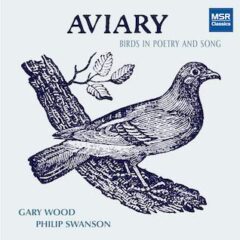 Philip Swanson writes: “It all started with William Butler Yeats’ poem, ‘The Wild Swans at Coole.’ One October day, as I was reading and reflecting on this wonderful poem, a melody for the opening line (‘The trees are in their Autumn beauty’) came to me. Several hours later, seated at the piano, I had written the opening to the song. In the following days, as I worked on it, the idea came up to write a song-cycle of poems on the subject of birds.
Philip Swanson writes: “It all started with William Butler Yeats’ poem, ‘The Wild Swans at Coole.’ One October day, as I was reading and reflecting on this wonderful poem, a melody for the opening line (‘The trees are in their Autumn beauty’) came to me. Several hours later, seated at the piano, I had written the opening to the song. In the following days, as I worked on it, the idea came up to write a song-cycle of poems on the subject of birds.
“After a bit of searching, I came across a beautiful book edited by Billy Collins, former American poet laureate, called Bright Wings: An Illustrated Anthology of Poems About Birds. The book, which features more than 100 works by authors from Catullus and Chaucer to those of today and wonderful illustrations by David Allen Sibley, offered me a wealth of material from which to choose.
“I decided to take on Wallace Stevens’ classic ‘Thirteen Ways of Looking at a Blackbird.’ In addition to being a great work, the haiku-like structure of the poems gave me an opportunity to express a wide range of musical voices. The listener will hear echoes of composers whose music has influenced me greatly, including Stravinsky, Bartok, Copland and Bernstein. The other poem I chose to set was a lovely piece by Annie Finch, ‘Great Grey Owl.’ This work has a more popular, jazz-influenced feel to it; think Alec Wilder.”

’13 Ways of Looking at a Blackbird, Part VII: O Thin Men of Haddam, a Wallace Stevens poem set to music by pianist-composer Philip Swanson, Vocal by Dr. Gary Wood. From the album Aviary (Birds in Poetry and Song) by Philip Swanson and Dr. Gary Wood.
About the principals, composer-multi-instrumentalist-teacher Philip Swanson, currently Professor of Music at Salem State University in Salem, Massachusetts, and the organist and choir director at the First Congregational Church in Rockport, MA, has been principal trombonist with the Miami Philharmonic in Florida and has performed with the Boston Symphony and Boston Pops, among many orchestras on his resume; in addition, he’s released seven acclaimed albums on the MSR label, preceding Aviary. Bariton vocalist Dr. Gary Wood—teacher, choral conductor and vocal performer—has covered the jazz, pop and classical waterfronts as a performer, along with church choirs, clubs and recitals. He earned a Doctor of Musical Arts in Choral Conducting from the University of Illinois, and recently retired from Salem State University in Salem, Massachusetts, where he had primary responsibilities as a choral conductor and teacher. He and Mr. Swanson share a long friendship, and Swanson dedicated the Aviary songs to Dr. Wood.

‘A Nightingale Sang in Berkeley Square,’ vocal by Dr. Gary Wood, with pianist Philip Swanson. From Aviary (Birds in Poetry and Song) by Philip Swanson and Dr. Gary Wood.
Aviary is a quiet, minimalist outing, much in the recital mode. How much its content will inspire reflection on birds is an open question, but there’s no doubting the artists’ hearts being in the right place. The album’s centerpiece is Swanson’s musical settings of Wallace Stevens’s 1954 poem, from his first published book of poetry, “Thirteen Ways to Look at a Blackbird.” The baker’s dozen parts of Swanson’s adaptation go by quickly—only one is more than two minutes long—with Swanson supporting Dr. Wood in austere fashion, via short phrases, fleeting riffs, comping or longer lines complementing Dr. Wood’s straightforward phrasing. Occasionally Swanson’s jazz roots surface, as in the swing ambience he fashions eagerly in Part 8: I Know Noble Accents. On other occasions he backs his vocalist with what could be called film noir soundscapes—sharp, jagged bursts of emotion, sinister sounding dissonance (Part 4: A Man and A Woman), or foreboding, almost funereal phrases (Part 7: O Thin Men of Haddam). The lack of much color in Dr. Wood’s otherwise authoritative vocals actually enhances the mood Swanson creates throughout; a certain deadpan quality lends mystery to the proceedings.

‘Baltimore Oriole,’ written by Hoagy Carmichael. Vocal by Dr. Gary Wood, with Philip Swanson on piano. From Aviary (Birds in Poetry and Song) by Philip Swanson and Dr. Gary Wood.
In keeping with Aviary‘s introspective nature, Swanson offers a soothing interlude in the form of a solo piano version of Horace Silver’s reflective “Peace.” His setting of W.B. Yeats’s “The Wild Swans At Coole” extends the mood and style of “13 Blackbirds” (with, and I could be wrong about this, a hint of Guaraldi in the piano accompaniment), although, in the end, it’s still a poem and it’s rhythms are not the rhythms of song, lending it a certain stilted quality in execution. Not so for the four standards included here: you can never go wrong with a Hoagy Carmichael song in your repertoire, and Aviary boasts two in the Johnny Mercer co-write, “Skylark” (a soaring performance by Dr. Wood), followed by the Carmichael-Paul Francis Webster evergreen ode to an avian love relationship, “Baltimore Oriole,” in which singer and accompanist perform with an easygoing freedom, exulting in the moment with Dr. Wood adding a frisky scatting section midway through, perhaps taking their cues from Hoagy’s own bluesy, swaggering, string- and woodwind-enhanced original. The album’s loveliest performance, with cabaret intimacy and much in the way of tender feeling, comes by way of the 1940 British chestnut featuring a migrant songbird at its center, “A Nightingale Sang in Berkeley Square,” with Dr. Wood savvily modulating his vocal to capture the song’s romantic patina in its full colors, with a subtly underplayed “I know because I was there” coda as the song winds down. The duo then closes out Aviary with a popular jazz standard dating from 1940, Tadd Dameron’s oft-covered “Lady Bird,” here delivered with freewheeling playfulness by both artists, Swanson’s piano right in step with and adding sprightly fills behind Dr. Wood’s scatting and vocalizing. Almost all the songs on Aviary were written when the world still had dew on it, to paraphrase Norman Maclean.
In the three albums featured here, music and nature are inextricably linked. Aviary speaks to that notion, Five Minutes for Earth and The Lost Birds fears for the latter’s future. Now what do we do?
